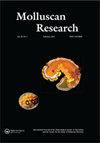在收获的潮间带海螺中发现对人类有潜在致病性的细菌
IF 0.6
4区 生物学
Q3 ZOOLOGY
引用次数: 0
摘要
摘要与海洋无脊椎动物相关的微生物在宿主的生理和生化过程中发挥着关键作用,并可能导致人类食源性疾病。生无脊椎动物是世界各地沿海美食的常见组成部分,如果它们的微生物组携带感染性细菌,食用它们可能对人类构成潜在风险。然而,这些物种的微生物组组成通常是未知的。在这项研究中,我们对来自马卡龙岛和葡萄牙大陆的商业开发海螺Phorcus sauciatus的16S基因进行了测序,以表征其消化系统和性腺的微生物组。目标是识别可能对人类构成威胁的细菌。总共鉴定了910个OTU,其中32个被归类为1级和2级风险物种。在这些菌株中,发现了20种相对丰度较高的致病菌株,并确定其为人类疾病的潜在驱动因素,包括黄微球菌和粘质沙雷氏菌。在这里,我们讨论我们对这些细菌的发现如何严重影响人类。我们的研究结果超出了这项研究的范围,因为这项工作也可能为揭示对其他贝类和无脊椎动物原始消费的进一步影响铺平道路。本文章由计算机程序翻译,如有差异,请以英文原文为准。
Occurrence of bacteria potentially pathogenic to humans in a harvested intertidal sea snail
ABSTRACT Microbes associated with marine invertebrates play a key role in the physiological and biochemical processes of the host, and can be responsible for food-borne diseases in humans. Raw invertebrates are a common component of coastal gastronomy worldwide and their consumption could represent a potential risk to humans if their microbiome hosts infectious bacteria. However, these species’ microbiome composition is usually unknown. In this study, we sequenced the 16S gene to characterise the microbiome of the digestive system and gonads of the commercially-exploited sea snail Phorcus sauciatus from the Macaronesian islands and mainland Portugal. The goal was to identify bacteria that might pose a threat to humans. In total, 910 OTUs were identified, thirty-two of which were found to be classified as Risk level-1 and -2 species. Among these, twenty pathogenic bacterial strains were found in high relative abundance and identified as potential drivers of human diseases, including Micrococcus luteus and Serratia marcescens. Here, we discuss how our findings on the occurrence of these bacteria could seriously affect humans. Our results are relevant beyond the scope of this study, as this work might also pave the way for uncovering further implications on the raw consumption of other shellfish and invertebrate species.
求助全文
通过发布文献求助,成功后即可免费获取论文全文。
去求助
来源期刊

Molluscan Research
生物-动物学
CiteScore
1.80
自引率
10.00%
发文量
27
审稿时长
>12 weeks
期刊介绍:
Molluscan Research is an international journal for the publication of authoritative papers and review articles on all aspects of molluscan research, including biology, systematics, morphology, physiology, ecology, conservation, biogeography, genetics, molecular biology and palaeontology.
While the scope of the journal is worldwide, there is emphasis on studies relating to Australasia and the Indo-west Pacific, including East and South East Asia. The journal’s scope includes revisionary papers, monographs, reviews, theoretical papers and briefer communications. Monographic studies of up to 73 printed pages may also be considered.
The journal has been published since 1957 (as the Journal of the Malacological Society of Australia until 1993). It is free to members of the Malacological Society of Australasia and the Society for the Study of Molluscan Diversity.
 求助内容:
求助内容: 应助结果提醒方式:
应助结果提醒方式:


